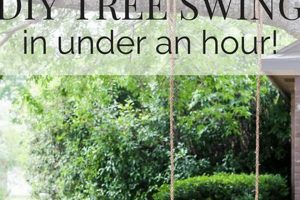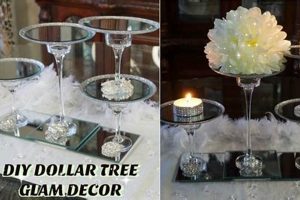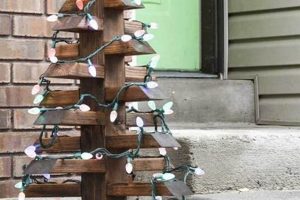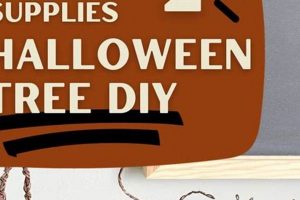The crafting of miniature evergreen replicas utilizing strands of spun fibers and do-it-yourself methodologies represents an increasingly popular holiday decoration trend. These handmade items offer a personalized alternative to traditional store-bought ornaments. For example, a crafter might wrap a cone-shaped form in green yarn to simulate the appearance of a small fir tree.
The appeal of creating these decorations stems from several factors, including cost-effectiveness, creative expression, and the opportunity to produce unique, handcrafted pieces. The practice aligns with broader movements emphasizing sustainability and personalized decor. Historically, handmade Christmas ornaments have provided a tangible connection to tradition and family history, representing a counterpoint to mass-produced goods. The construction of a decoration from yarn encapsulates these values.
Detailed instructions and material considerations for the fabrication of yarn-based Christmas trees are readily available. Furthermore, various techniques can be employed to customize the appearance of the finished product, including the addition of embellishments and the exploration of alternative color palettes. Subsequent sections will elaborate on specific construction methodologies, design options, and practical tips for successful creation.
Tips for Crafting a Durable and Visually Appealing Yarn Christmas Tree
The following guidelines aim to improve the construction and aesthetic quality of yarn-based miniature Christmas trees. Adherence to these recommendations can result in a more professional and long-lasting finished product.
Tip 1: Foundation Selection: Opt for a sturdy cone form made of cardboard or styrofoam as the base. A stable foundation is critical for maintaining the tree’s shape and preventing collapse during and after yarn application.
Tip 2: Yarn Selection and Preparation: Choose yarn of consistent thickness and texture for a uniform appearance. Pre-winding the yarn into a ball or cake before beginning the project can minimize tangling and facilitate smoother wrapping.
Tip 3: Adhesive Application: Employ a strong-hold craft glue applied evenly and sparingly to the cone. Excessive adhesive can saturate the yarn, leading to a stiff and unnatural look. Hot glue should be used with caution to avoid melting styrofoam bases.
Tip 4: Wrapping Technique: Maintain consistent tension while wrapping the yarn around the cone. Overlapping the yarn slightly will prevent gaps and create a fuller, more realistic tree effect. Work in small sections, allowing the adhesive to partially dry before proceeding to the next.
Tip 5: Securing the Yarn End: Secure the yarn end firmly at both the top and bottom of the cone with a generous amount of adhesive. Consider using a hidden knot to further ensure that the yarn does not unravel over time.
Tip 6: Embellishment Strategy: Add embellishments such as beads, sequins, or miniature ornaments after the yarn has fully dried. Apply embellishments sparingly to avoid overwhelming the tree’s design. Use a strong adhesive suitable for the chosen embellishments.
Tip 7: Finishing Touches: Inspect the finished tree for any loose ends or imperfections. Trim any stray yarn fibers and reinforce any weak points with additional adhesive.
By carefully considering these aspects of material selection, construction technique, and finishing details, the creator can produce a high-quality yarn Christmas tree that serves as a lasting holiday decoration.
These practical suggestions are intended to assist in the successful creation of a visually appealing and structurally sound yarn Christmas tree, enhancing its longevity and aesthetic appeal throughout the holiday season.
1. Materials Selection
Materials selection is a foundational element in the successful execution of a miniature yarn-based Christmas tree, directly impacting the final product’s aesthetic appeal, structural integrity, and longevity. The type of yarn chosen dictates the tree’s texture, color, and overall visual style. For instance, a bulky yarn creates a dense, plush appearance, while a finer yarn yields a more delicate and refined look. The selection of an appropriate base material, such as cardboard, styrofoam, or wood, is crucial for providing a stable foundation upon which the yarn is wrapped. An unstable or improperly sized base can lead to a distorted or collapsing tree. The adhesive used to secure the yarn to the base must also be carefully considered; its strength and drying time directly affect the durability of the construction.
The causal relationship between materials selection and the finished “diy yarn christmas tree” is readily apparent. Inappropriate material choices can result in a visually unappealing or structurally unsound product, negating the time and effort invested in its creation. For example, using a weak adhesive may cause the yarn to unravel over time, rendering the decoration unusable. Similarly, selecting a flimsy base may result in the tree losing its shape or toppling over easily. The availability of various yarn types, base materials, and adhesives allows for a wide range of creative possibilities, enabling crafters to customize their miniature trees to suit specific design preferences and aesthetic goals. This includes considerations for color palettes, texture variations, and embellishment options.
Ultimately, thoughtful materials selection is paramount to crafting a miniature yarn-based Christmas tree that not only embodies the spirit of the holiday season but also withstands the test of time. Challenges may arise from balancing cost considerations with quality requirements, or from navigating the myriad options available in the craft supply market. However, by prioritizing materials that offer both aesthetic appeal and functional durability, creators can ensure the enduring beauty and stability of their handmade decorations, contributing to a more personalized and meaningful holiday experience. This understanding of materials selection connects directly to the broader theme of craftsmanship and the value of intentional design in handmade objects.
2. Base Construction
Base construction is a critical determinant of the structural integrity and aesthetic presentation of a yarn-based miniature Christmas tree. The foundation upon which the yarn is applied dictates the overall form and stability of the decorative object. A poorly constructed base can lead to a misshapen or unstable final product, regardless of the quality of the yarn or wrapping technique. For instance, if a cone-shaped cardboard base is not properly secured at its seam, it may collapse under the weight of the yarn, resulting in a distorted tree. Conversely, a robust and well-proportioned base provides a solid framework for the yarn to adhere to, ensuring a symmetrical and visually pleasing outcome. The choice of base material, whether it be styrofoam, cardboard, or a pre-made cone form, influences not only the structural integrity but also the ease of yarn application and the overall cost-effectiveness of the project.
The selection and preparation of the base involve several practical considerations. The base’s size should be proportionate to the desired dimensions of the finished tree. Furthermore, the surface of the base must be clean and free of any debris that could interfere with the adhesion of the yarn. For styrofoam bases, it is advisable to use a low-temperature glue gun to avoid melting the material. Cardboard bases may require reinforcement with tape or additional layers of cardboard to prevent buckling or warping. An example would be reinforcing a cardboard cone with a layer of painter’s tape along the seam, creating a stronger, more durable bond. The angle of the cone, if applicable, also affects the aesthetic appeal of the tree; a steeper angle results in a taller, narrower tree, while a shallower angle creates a shorter, wider tree. Therefore, careful attention to the shape and dimensions of the base is essential for achieving the desired visual effect. Pre-made bases offer convenience and consistency, but they may limit design flexibility. Custom-made bases allow for greater control over the tree’s shape and size, but they require more effort and skill to construct properly.
In conclusion, the correlation between base construction and the overall quality of a yarn Christmas tree is undeniable. Overlooking the importance of a well-designed and structurally sound base can undermine the entire crafting process. Challenges may include sourcing appropriately sized and shaped bases, or mastering the techniques required to construct a stable base from scratch. However, by prioritizing a solid foundation, crafters can ensure that their yarn Christmas trees are not only visually appealing but also durable and long-lasting, thus creating a cherished holiday decoration that can be enjoyed for years to come. This focus on foundational elements mirrors the broader principles of sound construction in various crafts and DIY projects, highlighting the importance of a strong base for a successful outcome.
3. Yarn Wrapping
The process of yarn wrapping constitutes a fundamental step in the creation of a miniature Christmas tree crafted from yarn. This technique involves the systematic application of yarn around a pre-determined form, typically conical, to simulate the appearance of an evergreen tree. The effectiveness of yarn wrapping directly influences the aesthetic appeal and structural integrity of the finished product. Irregular or inconsistent wrapping can result in visible gaps or an uneven surface, detracting from the visual representation of a Christmas tree. Conversely, meticulous and uniform yarn application creates a dense and visually appealing surface, closely resembling the texture of foliage. A practical example involves wrapping a styrofoam cone with green yarn, overlapping each strand slightly to avoid exposing the underlying base material.
Specific yarn wrapping techniques can enhance the realism and visual interest of the yarn Christmas tree. Varying the yarn tension during the wrapping process can create subtle textural variations, mimicking the natural variations in foliage density found in real trees. Furthermore, incorporating multiple shades of green or other colors can add depth and dimension to the finished product. For instance, alternating rows of dark green and light green yarn can simulate the effect of shadows and highlights, enhancing the tree’s three-dimensional appearance. The method of securing the yarn ends, whether through adhesive application or knot tying, is crucial for preventing unraveling and ensuring the long-term stability of the wrapped surface. Improperly secured yarn can compromise the integrity of the entire structure, leading to eventual disintegration.
In summary, yarn wrapping is an indispensable component in the creation of a “diy yarn christmas tree,” with its execution directly impacting the final product’s visual quality and structural soundness. Challenges may arise in maintaining consistent tension and achieving uniform coverage, particularly for intricate or elaborately designed trees. However, by mastering the fundamental principles of yarn wrapping and employing appropriate techniques, crafters can produce miniature Christmas trees that are both visually appealing and durable, contributing to a more personalized and festive holiday atmosphere. This element links to the broader context of craftsmanship where technique shapes the final product.
4. Adhesive Application
The application of adhesive is a critical step in the construction of miniature yarn-based Christmas trees. The adhesive serves as the bonding agent, securing the yarn to the chosen base material, thereby determining the structural integrity and longevity of the finished item. Insufficient or improperly applied adhesive can result in yarn detachment, leading to a compromised aesthetic and a reduced lifespan for the decoration. Conversely, judicious and appropriate adhesive use ensures a robust bond, preserving the tree’s form and appearance. For example, utilizing a craft glue designed for porous surfaces, such as a fabric glue on yarn and a cardboard base, ensures a strong and lasting adhesion. Failure to select the correct adhesive could manifest as peeling yarn, rendering the finished product unacceptable.
The effectiveness of adhesive application extends beyond mere adhesion. It also affects the visual texture and overall appearance of the yarn Christmas tree. Over-application of adhesive can saturate the yarn, creating a stiff and unnatural texture, while uneven distribution can lead to visible glue lines or patches. Therefore, the technique employed in adhesive application is as important as the choice of adhesive itself. A thin, even layer of adhesive, applied strategically to both the base and the yarn, promotes optimal bonding without compromising the yarn’s texture or appearance. Furthermore, the drying time of the adhesive must be considered, allowing sufficient time for the bond to fully cure before handling or embellishing the tree. For instance, clamping or pinning the yarn in place during the drying process can prevent shifting and ensure a secure bond, especially in areas where the yarn is under tension.
In conclusion, adhesive application is an indispensable element in the creation of a miniature yarn-based Christmas tree. Its proper execution is paramount to the structural integrity, aesthetic appeal, and overall longevity of the finished product. Challenges may arise in selecting the appropriate adhesive for specific material combinations and mastering the techniques required for even and consistent application. However, by recognizing the critical role of adhesive and adhering to best practices, crafters can produce yarn Christmas trees that are not only visually pleasing but also durable and resilient, serving as cherished holiday decorations for years to come. This highlights the broader craft concept where even seemingly minor components impact the ultimate quality.
5. Embellishment Techniques
Embellishment techniques significantly enhance the aesthetic appeal and personalized nature of yarn Christmas tree projects. These techniques transform a basic yarn-wrapped form into a unique and visually compelling holiday decoration, reflecting the individual style and creative vision of the crafter.
- Bead Application
The strategic placement of beads, sequins, or other small decorative elements can add sparkle and visual interest to the yarn tree. Beads may be glued individually or strung together to create garlands that encircle the tree. Their color, size, and arrangement contribute significantly to the overall aesthetic, enabling the creation of themes ranging from rustic to elegant. For instance, small pearl beads evoke a classic, sophisticated feel, while brightly colored seed beads offer a more playful and whimsical effect. Improperly applied beads, however, can create an unbalanced or cluttered appearance.
- Felt Accents
Felt shapes, such as stars, snowflakes, or miniature ornaments, provide a tactile and visually distinct contrast to the yarn texture. These accents can be cut by hand or with specialized dies, allowing for intricate designs and precise shapes. Felt adheres readily to yarn surfaces with fabric glue, providing a durable and long-lasting embellishment option. The use of felt offers opportunities to incorporate thematic elements, such as woodland creatures for a nature-inspired tree or geometric patterns for a modern aesthetic. Overuse of felt accents can obscure the underlying yarn texture, diminishing the tree’s overall appeal.
- Ribbon and Lace Integration
Incorporating ribbon or lace adds a textural and visual dimension to the yarn Christmas tree. Ribbon can be wrapped around the tree in a spiral pattern, creating a garland effect, or used to create bows and other decorative elements. Lace adds a delicate and intricate touch, providing a contrast to the thicker yarn texture. The selection of ribbon and lace should complement the yarn’s color and texture, ensuring a cohesive and visually harmonious design. An example involves using a satin ribbon with a sheen that catches the light, adding a touch of elegance to the yarn tree. Using ribbons and laces with conflicting aesthetic styles can detract from the tree’s overall appearance.
- Yarn Manipulation
Beyond the basic wrapping technique, manipulating the yarn itself offers opportunities for embellishment. Braiding, twisting, or knotting the yarn can create textural variations and add visual interest to the tree. For instance, creating small pom-poms from yarn and attaching them to the tree simulates miniature ornaments. Similarly, incorporating yarn tassels or fringe adds a playful and whimsical element. These techniques require careful execution to ensure a balanced and aesthetically pleasing result. Overly complex yarn manipulations can overwhelm the tree, creating a cluttered and distracting appearance.
The effective implementation of embellishment techniques transforms a simple yarn Christmas tree into a personalized work of art. The careful selection and application of beads, felt accents, ribbon, lace, and yarn manipulations contribute to the tree’s overall aesthetic, reflecting the individual style and creative vision of the crafter. Conversely, poorly executed embellishments can detract from the tree’s appeal, resulting in a cluttered or unbalanced appearance. Ultimately, the judicious use of embellishment techniques elevates the yarn Christmas tree from a basic craft project to a unique and cherished holiday decoration.
6. Finishing Touches
The culmination of the creation process for a “diy yarn christmas tree” resides in the application of finishing touches. This phase, though often perceived as minor, holds substantial influence over the final aesthetic, durability, and overall impression of the handcrafted item. The effectiveness of securing loose yarn ends, trimming extraneous fibers, and meticulously positioning embellishments directly impacts the tree’s visual appeal and longevity. Neglecting these steps can lead to an unfinished appearance, diminishing the intended charm and potentially compromising the structure over time. For example, failing to adequately secure the yarn at the base can cause unraveling, eventually distorting the tree’s shape. Similarly, overlooking stray glue strands detracts from the neatness and professionalism of the finished piece.
The meticulous attention to detail during the finishing stage allows for the correction of minor imperfections and the refinement of the tree’s overall design. Adjustments to the placement of ornaments, beads, or other decorative elements can optimize their visual impact, ensuring a balanced and harmonious composition. Furthermore, the application of a sealant or protective coating, if deemed necessary, can enhance the tree’s resistance to dust, moisture, and other environmental factors, thereby extending its lifespan. A practical application of this understanding involves carefully inspecting the completed tree under adequate lighting, identifying any areas requiring further attention. This proactive approach ensures that the tree presents a polished and professional appearance, suitable for display or gifting.
In summary, the finishing touches represent a crucial, often underestimated, element in the “diy yarn christmas tree” creation process. They serve to refine the aesthetic, solidify the structure, and enhance the longevity of the handmade decoration. Challenges may arise in achieving a consistently high level of detail and in selecting appropriate protective coatings. However, the dedication to meticulous finishing touches transforms a simple craft project into a cherished holiday keepsake, reflecting a commitment to quality and craftsmanship.
Frequently Asked Questions
The following section addresses common inquiries regarding the creation of miniature Christmas trees from yarn, providing detailed and informative answers to guide the crafting process. These questions aim to clarify potential challenges and optimize the execution of this decorative project.
Question 1: What is the optimal yarn type for creating a durable and visually appealing yarn Christmas tree?
The selection of yarn should prioritize both durability and aesthetic qualities. Acrylic or wool yarns are generally recommended due to their resilience and wide availability in various colors and textures. Consider the thickness of the yarn relative to the desired scale of the tree; finer yarns produce a more delicate appearance, while bulkier yarns create a denser, more textured effect. The presence of metallic threads within the yarn can enhance the visual appeal, though this may impact the yarn’s overall structural integrity.
Question 2: What is the most effective method for securing yarn to the base of the Christmas tree to prevent unraveling?
A strong adhesive, specifically designed for porous materials such as yarn and cardboard or styrofoam, is essential for securing the yarn. Hot glue, craft glue, or fabric glue are suitable options. Apply the adhesive sparingly but evenly to the base, pressing the yarn firmly into the adhesive to ensure a secure bond. Allow sufficient drying time before proceeding to the next layer of yarn. At the termination point, apply a generous amount of adhesive to secure the yarn end, and consider tucking the end beneath adjacent strands for added security.
Question 3: How can a consistent and uniform yarn wrapping technique be achieved to avoid gaps or unevenness in the finished product?
Maintaining consistent tension is crucial for achieving a uniform yarn wrapping. Avoid pulling the yarn too tightly, which can distort the base, or allowing it to become too loose, which results in gaps. Overlapping each strand of yarn slightly as it is wrapped around the base ensures complete coverage and prevents the underlying material from being visible. Working in small sections and adjusting the yarn as needed helps maintain a consistent appearance throughout the project.
Question 4: What strategies can be employed to embellish a yarn Christmas tree without compromising its structural integrity?
The selection of embellishments should be proportional to the size and weight of the tree. Lightweight materials such as beads, sequins, and miniature felt shapes are less likely to compromise the tree’s structural integrity. Apply embellishments sparingly and strategically, using a strong adhesive to secure them in place. Avoid overloading the tree with excessive embellishments, which can create an unbalanced or cluttered appearance.
Question 5: What is the recommended method for cleaning or maintaining a yarn Christmas tree to prolong its lifespan?
Yarn Christmas trees should be stored in a dry, dust-free environment to prevent damage. To clean the tree, gently dust it with a soft brush or use a vacuum cleaner with a brush attachment on a low setting. Avoid using water or harsh cleaning agents, as these can damage the yarn or dissolve the adhesive. For heavily soiled areas, consider spot cleaning with a mild detergent and a damp cloth, allowing the area to air dry thoroughly.
Question 6: How can a crafter ensure that the base of the yarn Christmas tree is stable and prevents the tree from toppling over?
The stability of the base is paramount for preventing the tree from toppling. Select a base material that is sufficiently heavy and wide to provide adequate support. Consider adding weight to the base by filling it with sand, pebbles, or other heavy materials. Alternatively, attach the base to a wider, more stable platform using adhesive or fasteners. Ensure that the center of gravity is aligned vertically over the base to minimize the risk of tipping.
By addressing these common questions, the crafting process becomes more accessible and the final product more durable and visually appealing. The application of these principles elevates the quality and longevity of the crafted item.
Subsequent sections will explore alternative design options and creative variations for yarn-based Christmas trees, expanding upon the foundational techniques outlined above.
Conclusion
The preceding exploration of “diy yarn christmas tree” projects has illuminated critical aspects ranging from material selection to finishing techniques. The successful creation of such decorations hinges on a comprehensive understanding of these factors and their interdependencies. A properly executed “diy yarn christmas tree” represents a blend of aesthetic intention and practical craftsmanship, resulting in a personalized holiday adornment.
Future endeavors in this domain should prioritize sustainable material sourcing and innovative design adaptations. Further research into alternative yarn types and embellishment strategies could unlock new possibilities for creative expression. The enduring appeal of “diy yarn christmas tree” projects lies in their capacity to foster creativity and contribute to a more personalized and meaningful holiday experience. It is recommended that practitioners continue to explore and refine their techniques to maximize the aesthetic and structural integrity of their creations.







